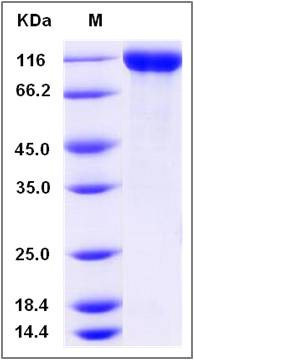Mouse Contactin 2 / CNTN2 Protein (His Tag)
D130012K04Rik,TAG-1,Tax
- 100ug (NPP3266) Please inquiry
| Catalog Number | P51111-M08H |
|---|---|
| Organism Species | Mouse |
| Host | Human Cells |
| Synonyms | D130012K04Rik,TAG-1,Tax |
| Molecular Weight | The recombinant mouse CNTN2 comprises 994 amino acids and has a predicted molecular mass of 108.7 kDa. The apparent molecular mass of the protein is approximately 110 kDa in SDS-PAGE under reducing conditions due to glycosylation. |
| predicted N | Gln 31 |
| SDS-PAGE |  |
| Purity | > 97 % as determined by SDS-PAGE |
| Protein Construction | A DNA sequence encoding the mouse CNTN2 (Q61330) (Gln31-Glu 1013) was expressed with a C-terminal polyhistidine tag. |
| Bio-activity | |
| Research Area | Neuroscience |Neurology process |Growth and Development |Axon Guidance |Adhesion Molecules in Axon Guidance |
| Formulation | Lyophilized from sterile PBS, pH 7.4 1. Normally 5 % - 8 % trehalose and mannitol are added as protectants before lyophilization. Specific concentrations are included in the hardcopy of COA. |
| Background | Contactins are a subgroup of molecules belonging to the immunoglobulin superfamily that are expressed exclusively in the nervous system. The subgroup consists of six members: Contactin-1, Contactin-2(TAG-1), Contactin-3(BIG-1), BIG-2, Contactin-5(NB-2) and NB-3. Since their identification in the late 1980s, Contactin-1 and Contactin-2 have been studied extensively. Axonal expression and the neurite extension activity of Contactin-1 and Contactin-2 attracted researchers to study the function of these molecules in axon guidance during development. Contactin-1 and Contactin-2 have come to be known as the principal molecules in the function and maintenance of myelinated neurons. In contrast, the function of the other four members of this subgroup remained unknown until recently. Contactin-2, also known as CNTN2, is a glycosylphosphatidylinositol (GPI)-anchored neuronal membrane protein that functions as a cell adhesion molecule. The human, rat, and chicken Contactin-2 are alternatively known as TAX1 (transiently-expressed axonal glycoprotein), TAG1 (transient axonal glycoprotein), and axonin-1, respectively. Human Contactin-2 shares approximately 91% and 75% amino acid sequence identity with rat and chicken Contactin-2, respectively. Contactin-2 is expressed by a subset of neuronal populations in the developing central nervous system (CNS) and peripheral nervous system (PNS). Contactin-2 is also expressed by oligodendrocytes and Schwann cells, which are myelinating glial cells of the CNS and PNS, respectively. Contactin-2 may play a role in the formation of axon connections in the developing nervous system. Contactin-2 is also involved in glial tumorigenesis and may provide a potential target for therapeutic intervention. During embryonic development, Contactin-2 interacts either in a homophilic, or heterophilic fashion with various transmembrane proteins. |
| Reference |
